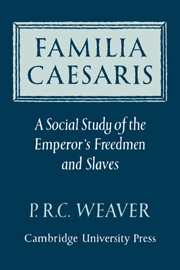Book contents
- Frontmatter
- Contents
- Preface
- Abbreviations
- INTRODUCTION
- PART I NOMENCLATURE AND CHRONOLOGY
- PART II THE FAMILY CIRCLE
- 5 Age at manumission
- 6 Age at marriage
- 7 Status of wives
- 8 Status of children
- 9 The Senatusconsultum Claudianum and the Familia Caesaris
- 10 Women in the Familia Caesaris
- 11 The marriage pattern of slaves and freedmen outside the Familia Caesaris
- PART III THE EMPEROR'S SERVICE
- APPENDIXES
- Bibliography
- Index
11 - The marriage pattern of slaves and freedmen outside the Familia Caesaris
Published online by Cambridge University Press: 07 October 2011
- Frontmatter
- Contents
- Preface
- Abbreviations
- INTRODUCTION
- PART I NOMENCLATURE AND CHRONOLOGY
- PART II THE FAMILY CIRCLE
- 5 Age at manumission
- 6 Age at marriage
- 7 Status of wives
- 8 Status of children
- 9 The Senatusconsultum Claudianum and the Familia Caesaris
- 10 Women in the Familia Caesaris
- 11 The marriage pattern of slaves and freedmen outside the Familia Caesaris
- PART III THE EMPEROR'S SERVICE
- APPENDIXES
- Bibliography
- Index
Summary
If the Familia Caesaris is indeed an élite in the slave and freedman classes of society, we would expect its marriage pattern to be significantly different from that of the slaves and freedmen outside the Familia. These slaves and freedmen themselves need not be considered as economically underprivileged; the only material available for such a study is their tombstones or funerary inscriptions – and the mere fact of being able to afford a tombstone, with or without decoration, as many of them conspicuously had, or of having access to a burial monument of a patron, implies security of a kind somewhat removed from the poverty of the ghetto.
A detailed study of the marriage pattern of these classes has yet to be made. The following discussion aims merely to supply material for such a study and to examine a control group as a basis of comparison between the Familia Caesaris and the slaves and freedmen outside it. To obtain a sufficiently large and homogeneous sample the sepulcrales of CIL VI, Parts 1–4, have been used. From these have been extracted the cases of marriages where the slave or freedman status of one of the partners is specifically stated or can be inferred with certainty (e.g. from the occurrence of ‘collibertus’, ‘patronus’, etc.), and where both partners are named and the relationship between them is specifically that of man and wife.
- Type
- Chapter
- Information
- Familia CaesarisA Social Study of the Emperor's Freedmen and Slaves, pp. 179 - 196Publisher: Cambridge University PressPrint publication year: 1972



